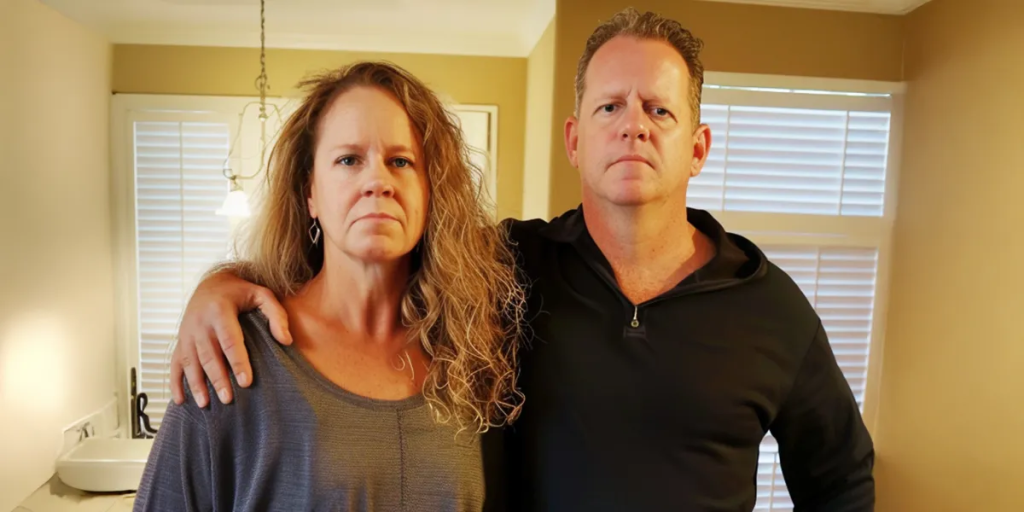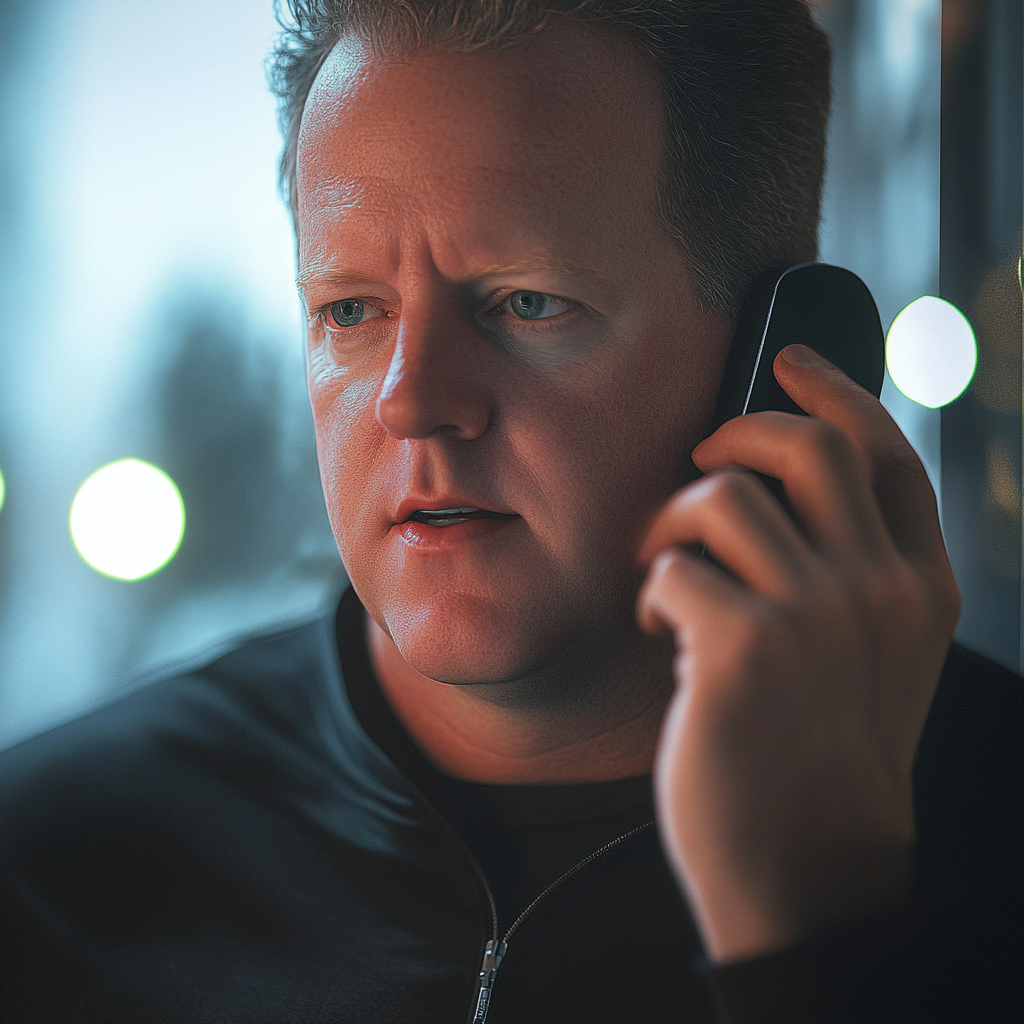Aric Hutchinson and Samantha Miller were beginning their journey as husband and wife when an unimaginable tragedy struck. What should have been the happiest day of their lives ended in heartbreak and loss.
Just hours after exchanging vows, the couple departed their wedding reception on Folly Beach, South Carolina, in a low-speed vehicle (LSV) adorned with sparklers. Operated by Aric’s relatives, Benjamin and Brogan Garrett, the street-legal cart was heading toward the couple’s accommodation, just two blocks away, when disaster struck.

A rented Toyota driven by 25-year-old Jamie Lee Komoroski collided with the back of the LSV at high speed. Data revealed Komoroski was driving 65 mph in a 25 mph zone and had barely attempted to brake before the crash, which occurred around 10 p.m.
Tragically, Samantha died at the scene from blunt force injuries, while Aric suffered severe injuries, including broken bones and a brain injury. He remains in critical condition. Benjamin Garrett was also hospitalized with serious injuries, while Brogan was treated and later released.
Komoroski, allegedly under the influence at the time of the crash, faces charges of reckless vehicular homicide and three counts of driving under the influence causing death. Each DUI charge carries a potential sentence of up to 25 years in prison. Authorities confirmed the LSV was properly equipped with lights and legal for nighttime driving.
Samantha’s mother, devastated by the loss, shared her grief: “She literally ran into my daughter going 65 miles an hour. Sammie and Aric were on the back of the golf cart, and she just whammed my child.”

Samantha’s sister, Mandi Jenkins, recalled the horrifying moment: “We were sitting on the balcony in our pajamas and heard the sirens. They kept going and going. When my sister didn’t respond to my texts, we drove to the scene, and what we saw was devastating.”
Komoroski refused to provide a breath sample at the police station. A warrant was issued for blood samples, and results are pending.

In the wake of the tragedy, Aric’s mother, Annette Hutchinson, created a GoFundMe campaign to cover medical expenses and funeral costs. She wrote: “Aric has had one of two reconstruction surgeries, numerous broken bones, and a brain injury. He has lost the love of his life.” The fundraiser has raised nearly $600,000 as of Wednesday, far surpassing its $100,000 goal.
Another campaign, started by Samantha’s sister Mandi, has raised $37,000 of its $10,000 goal to honor Samantha’s memory.
“Samantha was fearless, and that’s exactly how she lived her last day,” Mandi wrote. “She was so excited to start her life with Aric. You could feel the love on that beach.”
Our deepest condolences go out to Samantha’s family and friends. May she rest in peace.
Please share this story to help spread awareness about the devastating impact of driving under the influence.
I Kicked My In-Laws Out of My Daughter’s First Birthday Party After They Crossed the Line

I thought my daughter’s first birthday party would be filled with love, laughter, and cherished memories. Instead, I ended up kicking my in-laws out after they did something unexpected.
You’d think a child’s birthday would bring out the best in everyone, right? Nope. That wasn’t true for my in-laws, James and Diane.
It’s been a year since I became a mom, and while parenting has its challenges, dealing with my husband’s family sometimes feels like the hardest part.
Let me explain everything from the beginning.

A woman thinking while looking outside the window | Source: Midjourney
Becoming a mother was the most transformative experience of my life.
A year ago, I welcomed my daughter, Lily, into the world, and she instantly became my whole universe. I still couldn’t believe how quickly time had flown. One moment, I was cradling a newborn, and now here I was, planning her first birthday party.
Honestly, it wasn’t as easy as it sounds. I’d like to thank Mark, my husband, for being there for me through it all.

A man standing in his house | Source: Midjourney
Whether it was midnight feedings or soothing Lily when she was teething, he was always by my side.
“Can you believe she’s already a year old?” I said one evening while we sat on the couch, going through old photos.
“Time flies, doesn’t it?” Mark replied, smiling as he looked at a picture of Lily in her hospital blanket. “So, what’s the plan for the big day?”

A man looking at his wife | Source: Midjourney
“I was thinking of hosting it at home,” I said. “I want it to be intimate. Umm, just close friends and family. It feels more special that way, don’t you think?”
“I love that idea,” he smiled. “Our house, our rules. Let’s make it memorable for Lily.”
With his support, I got to work.
For weeks, I planned every detail. I wanted it to be a day where everyone felt at home, which was why I also included a note on the invites asking guests to leave their shoes outside.

A woman preparing digital invites | Source: Pexels
To make things easier, I even bought brand-new spa slippers in various sizes for anyone who didn’t want to walk around barefoot.
Most of our friends and family were excited about the party. Everyone, that is, except James and Diane, my in-laws.
The conversation I had with them when I called to invite them still played in my mind.
“A party at home?” James said, his tone dripping with disapproval. “For Lily’s first birthday? Don’t you think something bigger would’ve been more appropriate? Like a restaurant or a park? It’s a milestone, after all.”

A man talking to his daughter-in-law on the phone | Source: Midjourney
“I get that, James,” I replied. “But we wanted to keep it small, with just close family and friends. It feels more personal this way.”
“It just seems… underwhelming,” Diane added, clearly unimpressed.
“Well, we’re excited about it,” I said. “And I hope you can make it.”
“We’ll see,” James replied before abruptly ending the call.
It wasn’t the first time they’d been critical. Over the years, I’d come to expect it.

A woman standing with her arms folded | Source: Midjourney
They were the kind of people who found flaws in everything, and hosting a party at home was apparently no exception.
Still, I tried to stay optimistic. I hoped they’d set their opinions aside and just enjoy the day with us.
Little did I know their visit would leave me with no choice but to take a stand.
I woke up at dawn on the morning of Lily’s birthday and started preparing everything. Mark and I were all set to put up pink and gold balloons and a “Happy Birthday” banner that we’d picked up from the store.

A “Happy Birthday” banner | Source: Pexels
I’d also ordered a custom-made three-tiered cake with sugar flowers and a little crown on top. Everything was perfect.
Mark and I had just finished setting up when the doorbell rang. The first guests had arrived, and soon, the house was filled with chatter, laughter, and the happy squeals of toddlers running around.
Lily, dressed in her tiny pink party dress, was beaming as she crawled from one guest to another, soaking up the attention.

A baby girl in a pink dress | Source: Pexels
Then, just as I was starting my toast to Lily, the front door opened with a bang. It was James and Diane.
And they were an hour late.
“Oh, don’t mind us,” Diane announced loudly, waving as all eyes turned to them. “We’re late because I had to get my hair done. I thought at least one woman should look decent at this party.”
Mark and I exchanged a look, but I plastered on a smile and continued my toast, trying to ignore the interruption.
As soon as I finished, Diane called out, “Well, I hope the cake tastes better than it looks.”

A woman standing in her stepson’s house | Source: Midjourney
What the heck? I thought. How dare she?
Then I told myself it wasn’t worth ruining the day over a comment. I just ignored her comment, unaware that this was the point where things would start to go downhill.
First, Diane handed me a gift bag. Inside were secondhand baby clothes that looked like they’d been picked up at a yard sale. They were visibly dirty, the tags were gone, and they had a faint mildew smell.
“Babies don’t care what they wear,” Diane said with a smile. “No need to waste money on fancy stuff.”

A woman talking to her daughter-in-law | Source: Midjourney
Unbelievable, I thought. But I managed to stammer out a “Thank you.”
I told myself maybe they were struggling financially. Maybe they didn’t have enough money to buy new clothes.
But then came the moment that pushed me over the edge.
As I mingled with the guests, I noticed muddy footprints trailing across my tile floor. I turned to see James and Diane, still wearing dirty shoes, stomping through the living room.
My heart sank as I saw the mess they’d made on the rugs where Lily had been crawling just minutes earlier.

A dirty rug | Source: Midjourney
Taking a deep breath, I approached Diane.
“Hi, Diane. Could I ask you to take off your shoes or put on the slippers? We’ve been asking everyone to do it to keep the floors clean for the kids.”
Diane barely glanced at me. “Oh, please. Our shoes are clean. And anyway, that’s an Asian thing, isn’t it? White people don’t do that.”
“Actually, it’s just a house rule for us,” I said, trying to stay calm. “My daughter crawls on these floors, and I’d like to keep them clean.”

A woman talking to her in-laws | Source: Midjourney
James, who’d been eavesdropping, chuckled. “That dirt is from your own front yard! Maybe you should clean the porch better if you don’t want dirt inside.”
My patience was wearing thin, but I took another deep breath and tried again, this time addressing them both.
“Look, I’m not asking for much. It’s a simple request to take off your shoes or wear the slippers I’ve provided. Everyone else has done it without issue. Why can’t you?”

An upset woman talking to her father-in-law | Source: Midjourney
Diane rolled her eyes, crossing her arms. “Because it’s ridiculous, that’s why. It’s just dirt! You’re acting like it’s the end of the world. Honestly, Anna, you’re ruining the party with all your nitpicking.”
That’s when Mark stepped in. He knew his parents were being unreasonable again.
“Dad, Diane, we’re asking this out of respect for our home,” he explained. “It’s not just about dirt. It’s about setting an example for Lily. If everyone else can follow the rules, so can you.”

A man looking straight ahead | Source: Midjourney
James smirked, leaning back as if he owned the place. “This is why people say you two are impossible. Especially your wife, Mark. Always making a fuss over nothing.”
That was the breaking point. The hurt and anger I’d been holding back finally spilled over.
“If respecting our home and my daughter’s birthday makes me impossible, so be it!” I yelled. “But I won’t stand here and let you ruin this day for her or for us. If you can’t follow a simple rule, you’re not welcome here.”

A woman yelling in her house | Source: Midjourney
Diane looked at me with wide eyes. “So, you’re kicking us out? Over shoes?”
“Yes,” I said firmly. “This is our home, and these are our rules. If you can’t respect them, you need to leave.”
They sputtered protests, but I wasn’t backing down. I walked to the front door, opened it, and gestured for them to leave. “Out. Now.”
For a moment, they stood frozen, shocked that I’d actually stood my ground. Then Diane grabbed her purse with an indignant huff.
“This is ridiculous. Mark,” she said. “I hope you realize what kind of wife you’ve married.”

A woman looking at her stepson | Source: Midjourney
Mark, to his credit, didn’t flinch. “I do, and I couldn’t be prouder of her. Please go.”
With one last glare, they stormed out, slamming the door behind them. Everyone was quiet for a moment as they thought of what to say. Then, Mark stepped forward and wrapped his arms around me.
“You did the right thing,” he whispered.
The party continued, and without James and Diane’s toxic presence, the atmosphere became lighter and more joyful.
But wait… This isn’t where the story ends.

Balloons on a wall | Source: Pexels
The next day, James called Mark, furious about being “humiliated” in front of everyone. But Mark stood his ground and calmly explained why we’d asked them to leave.
When James realized he wouldn’t get an apology, he hung up in anger.
A week later, karma came knocking.
A mutual friend informed me that Diane had posted on social media about her salon trip and the party, only to have people drag her for wearing muddy shoes into a house with kids. She’d even earned the nickname “Dirty Diane.”
I couldn’t stop laughing after learning that. Dirty Diane? Haha! That’s something Diane will never forget!

A woman smiling | Source: Midjourney



Leave a Reply